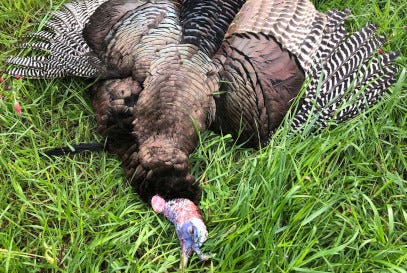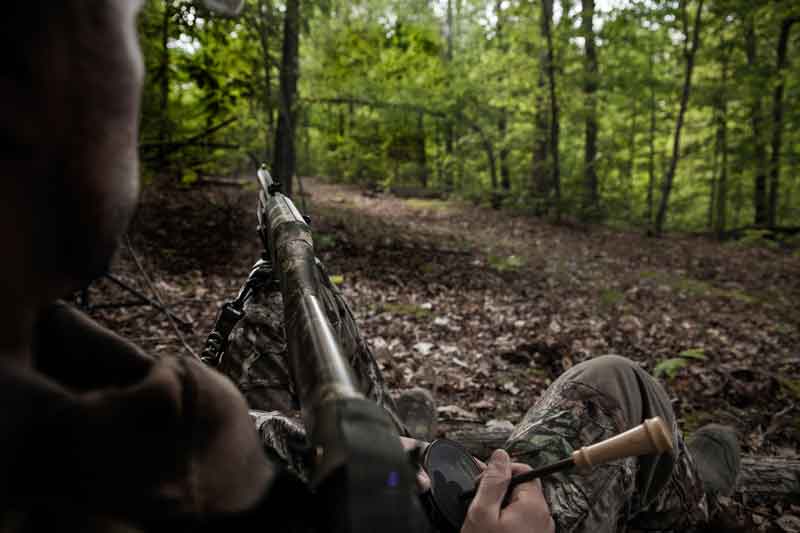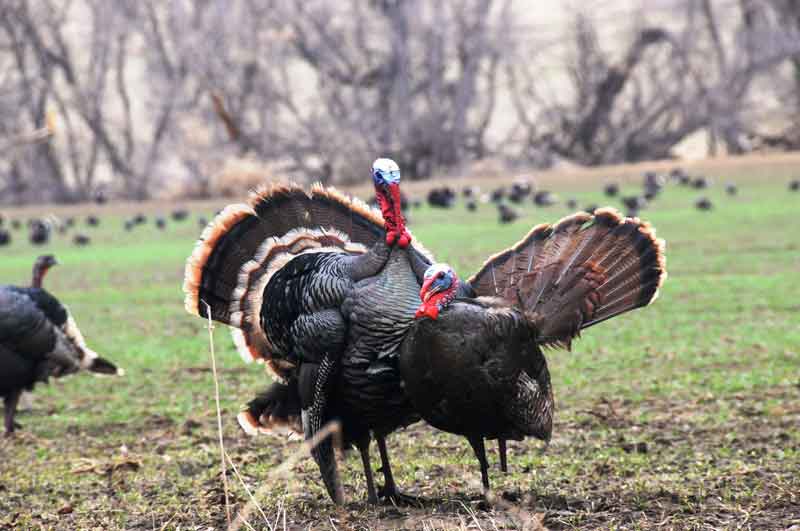- Apr 18, 2016
Turkey Vernacular - Basic Vocabulary Turkey Hunters Should Know
Turkeys judge you by your vocabulary.
Be fluent.
There’s nothing quite like a turkey hunt. Whether locating roosting birds or luring away a henned-up Tom, turkey hunting is an addiction you must experience. Folks not familiar with turkey hunting can find the terminology a bit confusing. That’s why Knight & Hale’s Chris Parrish constructed the ultimate glossary for all things turkey hunting. Read below – we think there’s something for everyone, novice and veteran hunters alike.
Blind – A blind can be a pop up style or a manmade blind, using sticks and limbs for a natural setting. Both work well and when hunting very open terrain. With beginning hunters this method may be needed to keep any movement from being seen. This is a great method to use when bow hunting. Pop up blinds are nice during inclement weather.
Blind Calling – Method of hunting and calling where the hunter sets up in an area that has good sign and that they have seen turkey frequent. Sitting and calling periodically every 15 to 20 minutes over a few hours. This method can be very successful when turkeys are not very vocal and are not readily seen or heard.
Box call – Box call normally consists of a box of two side with a paddle lid that when brought across the edge of the box surface produces a double not turkey yelp. Some boxes have a thick and thin side so as to represent both a gobbler and a hen while other just two different hens. While there are many different configurations, box calls are typically easy to learn and some of the most realistic sound in the turkey woods.
Brood – A brood is made up of a newly hatched group of young turkeys in mid-summer. While hens normally lay between 12 and 16 eggs the mortality rate is high and normally only half or less survive.
Cannon Net – A cannon net has been used for many years by conservation groups to trap and transfer turkeys to new locations. Many times it’s to help with population management or to start turkeys in new areas.
Choke tube – Part of your shotgun needed to produce a tight pattern at optimal ranges to ethically harvest the turkey.
Clutch – This is the term used to describe the eggs in the nest by which the hen lays and sets on until hatching. Normally consisting of 12 to 16 eggs.
Diaphragm call – This is a call made up of an aluminum frame and surgical latex stretched to a certain tension inside the frame, and water-proof tape. While the mouth call produces some of the most realistic tones and sounds it can be much more difficult to master. This call requires practice and patience to learn. Once a hunter is comfortable, diaphragms are totally hands free. Mouth calls are made with many different styles and thicknesses of latex, they also feature a multitude of cuts to produce many different tones and pitches. Hunters will need to try several different calls to find the best style for their personal use.
Drumming - this is a call used by the gobbler to attract hens during the spring mating ritual. This is usually done when he is in close quarters with a hen or in his strut zone while trying to attract. Drumming is typically of a low frequency and can be difficult to hear for some people. Many turkey come to calling without gobbling and only drumming so all hunters need to be very aware of this sound.
Fighting Purr – A call made by both males and females during a battle of dominance. This call can be produced with the K&H fighting purr call as well as using a friction type call along with a mouth call at the same time. This is a great call to use during the early season when the pecking order/ dominance is being established or when a gobbler is with hens and he is reluctant to come. Often times this call will cause him to come to a fight – much like rattling for deer.
FLOP – This is the sound you hear most often after you have made a good shot on the turkey as he is flopping around on the ground. However you can use a real wing or manmade wing to simulate the flopping of wings as the turkey fly’s down. Often times this incorporated with hen calling and close the deal on a roosted turkey wanting to hang up and wait for the hen to come to him.
Friction call – These particular calls are made up of wood, acrylic or plastic molded pots that hold a surface such as Glass, Slate, Ceramic, Aluminum and others. The surface is prepped with scotch brite or sand paper so there is friction between it and the striker which is a peg made up of wood, metal and or plexi glass. The striker is used by bring it across the grain prepared surface and can create all turkey vocabulary when mastered.
Gobbler – This is the adult male of the turkey species. This bird can weigh upwards of 25 plus pounds and has a beard that grows out of his chest along with spurs on his lower legs. The spur length signifies his age. He supports a full fan consisting of 18 tail feathers and uses this to display during the mating season. Along with this he gobbles as well as spits and drums to attract hens.
Hen – The adult female of the turkey specie. The hen weighs around 12 to 14 pounds, however there have been some bigger. She has a brown buff color to blend in when setting on the nest. The hen in most cases goes to the gobbler during mating, however she has a full vocabulary. While the hen normally does not have a beard or spurs there have been several recorded harvest showing both.
Jake – This is the young immature male turkey specie, the Jake normally weighs 12 to 15lbs during his first spring, more often than not he will not gobble due to his age and being insubordinate. The jake also will have 5 tail feathers in the middle higher than the remaining feathers.
Jenny – The Jenny is the immature hen less the a year old, while she may be able to bread it is normally very late in the mating season and more often than not is in tune with her mothering skills and loses the clutch. The jenny is around 6 to 8 pounds, she has the same coloration of an adult hen but a somewhat rough look due to immature plumage.
Kee-Kee - This is a call all turkeys can do whether young or adult, however it is primarily thought of during the fall of the year when the young birds are learning to call and split up from the adults. The call can be performed on both friction and mouth calls very well.
Pattern – While we think of patterning a deer to have more knowledge on how and where to hunt him, turkey can also be patterned especially if they are undisturbed. They tend to roost close to the same general areas and use the same course of travel unless they are disturbed by hunting pressure, predators or a new and different agricultural practices. By noting these daily habits and routines you better chose a set up and calling location, thus improving odds of success.
Patterning your shot gun- be sure to shot your gun at various ranges with several turkey loads using a few different shot sizes, using a turkey head type target. This will allow you to know what shell and shot size gives you the most uniform and dense pattern. Along with that you will know your maximum effective range. Find a photo of someone patterning on Internet and show the shot target.
Poult - The poult is a newly hatched turkey ranging from 1 day old and until they get through the first spring. They are extremely small when hatched about the size of a golf ball and very susceptible predation and inclement weather.
Push/Pull box call – Much like the standard box, this call uses friction to produce sound. The push/pull is much easier and uses a dowel rod connected to a wood or acrylic striking surface that runs against a wood pyramid wedge to produce turkey sounds. The push/pull can be used by pushing the dowel with you finger, hand, or thumb, along with being pulled between your index finger and thumb. This call is certainly not just for beginners, but is the best call to learn the tones and rhythm for first time callers.
Roost – This is a place where the turkeys up in to the trees at night. Turkeys like to roost near water if possible or on the sides of ridges. Old timers claimed this to be due to predation.
Score – Several years ago, The NWTF came up with a scoring method for gobblers. This method is used to see just how big your trophy turkey is by using many different measurements.
- Spur length x 10 Example 1 inch spurs on each leg would equal 20 inches
- Beard x 2 Example a 10 inch beard would equal 20 inches
- Then the weight of the bird is taken, if this turkey weighed 25lbs then the total score would be 65.
Slate – This is a type of surface used in friction style calls. Very user friendly and produces softer more mellow tones.
Stalking – Method of sneaking up in range of an animal/turkey using stealth and terrain to do so.
Striker – Used in combination with friction style calls, the striker is used to scratch the friction call surface and creates the sounds.
Strutting – The gobbler does this when showing off for his hens, this is a part of the turkey mating ritual, and is used to attract the female and show dominance to other males.
Strut marks - these are small lines left in the soft soul or on sandy roads by the wings of a strutting gobbler. Many times terrain or soul type doesn't show this sign but when found is for sure a place to set up and call. Find pics on internet if strut marks.
Turkey vest – Many years ago the Turkey vest came about, giving the need for the hunter to store his calls and a way to carry the big bird out of the woods. While there are many different types and styles the hunter will need to look through the options and style that best fit their need.
Tube call – The tube call is a small molded tube or handmade pill bottle with a piece of surgical latex stretched or the open end. This call was the first call Knight & Hale invented. The tube call can produce all calls of the wild turkey and is especially good at gobbling and load cutting for locating. The tube call does require a little practice to master but is great call to have in your arsenal.
Wattle – These flabby and elongated bits of skin that dangle off turkeys' necks typically are a rather muted and subtle color -- specifically dull and reddish or grayish. When their mood changes, however, that often changes the color of the wattle too, to a much more conspicuous intense red.



